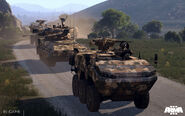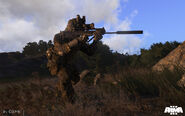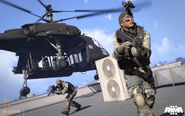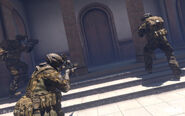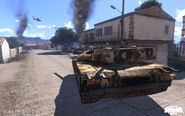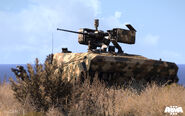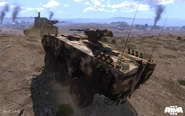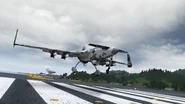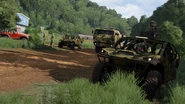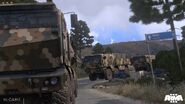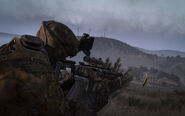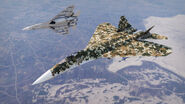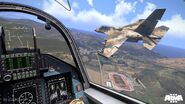
CSAT flag
The Canton Protocol Strategic Alliance Treaty (alternately CSAT for short, and in Simplified Chinese: 广东条约战略联盟组织) is an OPFOR faction in ArmA 3.
They are a military and economic alliance that consists of Eastern nations, and serve as a direct counterpart to NATO.
The bulk of the coalition's military might is divided up into different forces depending on the region that they operate in; as of current, this consists of Mediterranean (Altis), Pacific (Tanoa), and North African (Malden) branches.
Overview
| « | Formed at the apex of the Canton Protocol summits, this strategic alliance of states is built upon the goals of mutual defense, expanded global influence, and sustained economic growth. Set against the context of foundering economies and civil unrest across the west, CSAT has risen in prominence over the last decade. Investment in shared civil and military technology and the aggressive pursuit of opportunities and partnerships throughout Asia, South America and North Africa has led to a sharp increase in strategic tension across the globe, as traditional spheres of power and influence are encroached upon. Recently partnering with the government of The Republic of Altis and Stratis, joint civilian and military projects are supported by an independent mechanized brigade-sized force officially operates under the authority of Col. Vahid Namdar. Official ArmA 3 site description
|
» |
Background

Griffin Regiment's national flag patch
Headed predominately by the People's Republic of China and the Republic of Iran, CSAT as whole consists of several other East Asian, Middle Eastern, and possibly even former NATO and Central Asian member states.
Other known members include the Republic of Belarus and several North African countries. The organisation has also made offers to the Russian Federation for full membership, and are partnered together on trade and technology sharing - though the latter has yet to make an official decision.
With the sharp decline in Western geopolitical and economic soft power over the past two decades, CSAT's influence throughout the world has risen significantly and has allowed it to encroach into regions that were traditionally pro-West.
As seen during the events of the Prologue, CSAT's dominance over world affairs is clearly demonstrated in their interactions with the NATO peacekeepers of Task Force Aegis. The peacekeepers are reluctantly forced to abide by orders to step aside whenever CSAT forces are present, and are also unable to countermand any CSAT directives issued to the AAF.
Structure
As of the events of Apex Protocol, CSAT itself is divided up into three known (but not exclusive to) "branches" that are based in different parts of the globe. This consists of:
Mediterranean

Griffin Regiment's emblem.
Mediterranean CSAT forces operating on the Republic of Altis and Stratis consist of the brigade-sized 24th MECH INF Regiment from the Iranian Armed Forces as part of Griffin Regiment.
The 1st INF BN, 2nd MECH INF BN, 3rd ARMOR BN, 4th RECON SQDN, 6th Rotary Wing BN, and 7th Supply BN also operate under the 24th, all under the direct command of Colonel Vahid Namdar.
Pacific
CSAT forces stationed in the South Pacific near the Horizon Islands consist of an unknown regiment-sized force from the Chinese People's Liberation Army.
Their composition is unknown, as is the name of their leading officer, though the entire force falls under the direct command of Xu Haifeng, the supreme commander of all CSAT forces operating in the Pacific.
North Africa
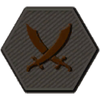
Scimitar Regiment's emblem.
A detachment of mechanised troops from the Scimitar Regiment, which consists of the armed forces from unknown North African member states, are deployed to the island of Malden.
They are based alongside a small fighter wing from the Chinese People's Liberation Army Air Force, who are stationed at the former U.S. airbase north of the island near La Trinite.
History

As Western influence falters, CSAT takes charge and leads the world both as an economic and military powerhouse.
CSAT's meteoric rise takes place amidst the backdrop of a two decade-long economic depression throughout the European Union and the United States.
While its geopolitical adversaries remain bogged down by domestic issues, CSAT's members have been bolstered by decades of unparalleled growth and technological advancement.
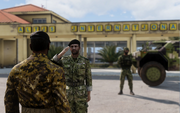
Ostracised by the EU, Southern European countries turn eastward for help.
Every year, Western and Eastern nations alike continue to seek membership in the hopes of gaining a share in the bloc's prosperity. The latest summits, first held in the Syrian capital of Damascus and in Russia's Moscow later that year, have already gained the coalition several new members.
| « | Our CSAT partners recognise the new truth. The potential of our nation. We share with them and grow. They represent the new future. Our new future, our new truth. Incumbent leader of the Republic of Altis and Stratis, Colonel Georgious Akhanteros, reaffirms his nation's commitment to welcoming CSAT investment
|
» |
In Southern Europe, countries suffering from harsh austerity measures imposed by the EU have turned to seek investments and humanitarian aid relief from the Republic of Iran. Meanwhile in the Asia-Pacific region, military victories in proxy wars against the U.S. has allowed China to maintain full dominance over the South China Sea.
Even as the 2030s draw to a close, its Western rivals remain convinced that CSAT's rise can be halted. But with each year's passing, the coalition's influence and reach only continues to strengthen; its ascension to status of being the world's premier superpower, very much appears to be inevitable.
NOTE: Though their exact date of formation has never been outright stated, it can be surmised that the organisation has been in existence for at least a decade prior to the events of The East Wind, as they were actively involved with the events of the Altian Civil War and also influencing Malden in the 2020s.
Events of Beyond Hope (2026)
| SPOILER ALERT |
|---|
NOTE: This section contains spoilers from ArmA 3's Tac-Ops Mission Pack DLC scenario 'Beyond Hope'. Nine years prior to the events of The East Wind, the island nation of the Republic of Altis and Stratis falls into chaos after an Altian military officer called Georgious Akhanteros launches a coup against the civilian government and forcibly seizes power. His success was largely due to the fact that the coup was covertly aided by CSAT. They not only provided him funding, but also political support to prop up his junta as the legitimate government of Altis against the Western-backed, pro-civilian government loyalist forces. After four more years of bloody civil war, the CSAT-backed AAF are finally able to decisively defeat the loyalists in battle, and are given recognition as the official government of the republic. |
Events of the Prologue (2034)
| SPOILER ALERT |
|---|
NOTE: This section contains spoilers from ArmA 3's 'Prologue' campaign.  With CSAT's blessing, the AAF violently crush all protests against their new government While victorious, Akhanteros' government was hugely unpopular and faced rebellion from its civilian population, as well as from within the military itself, which had grown corrupt and bloated in no small part thanks to CSAT's "aid". A new insurgency group that was formed from the ashes of the loyalists would eventually begin to openly rebel against the AAF. With the threat of yet another full-blown civil war primed to begin, the international community stepped in to intervene. CSAT immediately offers to provide counterinsurgency and humanitarian assistance to the AAF, which is graciously accepted by Akhanteros. Soon after, a meeting is arranged between the AAF and the FIA in order to negotiate a ceasefire between the two sides, with the sit-down set at the old capital of Kavala. In reality, both sides had ulterior motives behind the meeting; the AAF intended to eliminate the insurgency's leaders in one stroke, while the guerillas intended on starting an uprising in the city. With CSAT backing them however, the guerillas' attempted uprising was easily crushed by the AAF. Survivors are brutally interrogated and then executed (implied to have been directed by CSAT officers present at the site), much to the disgust of the NATO peacekeepers. |
Events of Remnants of War (2034)
| SPOILER ALERT |
|---|
NOTE: This section contains spoilers from ArmA 3's Laws of War DLC 'Remnants of War' campaign. Barely a week after the failed uprising in Kavala at the height of the counterinsurgency campaign, the village of Oreokastro to the north-west of the country is taken over and fortified by the FIA. With his government's stability at stake (and under CSAT pressure), Akhanteros orders that the village be taken back; through lethal force if necessary. The siege does not go according to plan however, as the AAF suffer one humiliating defeat after another from the guerillas, who in spite of their losses, hold out longer than either side had expected them to.  The alleged CSAT cluster bomb responsible for razing Oreokastro to the ground. Increasingly frustrated by his incompetence and continued failures, CSAT pressures Akhanteros into taking the village back once and for all. Whether out of sheer desperation or deception, a cluster bomb airstrike is eventually directed towards the village by an alleged 3-man CSAT special forces team. The brazen airstrike devastates the entire village and results in the deaths of almost every civilian and guerilla entrenched inside. |
Events of The East Wind (2035)
| SPOILER ALERT |
|---|
NOTE: This section contains spoilers from ArmA 3's 'The East Wind' campaign. The loss of Oreokastro dealt a significant blow against the FIA, but its destruction had ironically also done much harm to the AAF's already poor reputation, with the village becoming a rallying symbol for the FIA's recruitment efforts. Defections from the AAF were at an all-time high, with low morale and corruption becoming even more rife from within the organisation. 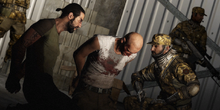 CSAT forces interrogating FIA guerillas CSAT leadership cared little for these concerns however, and merely stepped up their aid efforts and counterinsurgency training, while on occasion intervening to assist the AAF in rooting out guerilla cells. This aid did come with strings attached however, as CSAT laid out conditions that the country's sole international airport would be reserved for their exclusive use as a military airbase, along with setting up various research facilities on the island. With Akhanteros in their pocket, he quickly agrees and permits CSAT to establish their facilities on the island, essentially pushing aside NATO forces to make way for them. SurviveAfter a supposedly unprovoked attack by NATO forces, the AAF launch a counterattack against the peacekeepers of Task Force Aegis on the island of Stratis. The attack almost wipes out the task force, but the survivors manage to regroup and somehow manage to retake the initiative from the AAF. Forced to retreat, the AAF appeal for CSAT to intervene. To the surprise and shock of the peacekeepers, CSAT launch an all-out counterattack against the remaining NATO forces, and eventually eliminate what's left of the group. Stepping StoneNOTE: Stepping Stone takes place during the events of The East Wind's Adapt episode. 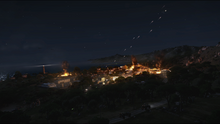 The invasion of Malden begins, with NATO forces attacking the towns of Le Port, Cancon, and then Hourdan Responding to the AAF's surprise attack against the peacekeepers of TF Aegis, a U.S.-led task force invades the island of Malden in order to secure a safe passage through to the Republic of Altis and Stratis. Though the Chinese forces on the island refuse to partake in any of the hostilities, the North African Scimitar Regiment retaliates against NATO forces and does not stand down. The Chinese government further denounces any involvement in the fighting, and essentially gives a green light to the NATO task force to continue with their operation. The last of Scimitar Regiment's forces are finally defeated after a major battle at Dourdan, and are forced to surrender to the NATO task force. AdaptWhile TF Aegis as a whole were taken out, certain members of the group had made it intact to the mainland, where they immediately began providing assistance to the FIA's rebellion efforts. The FIA's growing numbers, combined with the AAF being pressured by CSAT into dealing with the group by any means necessary, meant that the AAF were forced to use more heavy handed tactics to deal with the group. This stretched them thin from trying to maintain a presence everywhere, and the AAF were slowly bled dry by the FIA after multiple operations result in the loss of almost all of the northern and western parts of the country. Though CSAT forces did intervene on occasion (and whenever they did, they inflicted heavy losses on the guerillas as seen in the operation on Kavala), they mostly refused to provide direct support for the AAF outside of loaning their heavy armour assets. 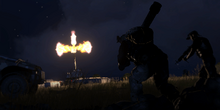 CSAT's artillery battery at Poliakko comes under fire from FIA guerillas Ultimately, CSAT forces are faced with the prospect of having to fight against a NATO invasion force, which quickly overruns both Stratis and the western parts of the mainland. They set up an artillery battery at the town of Poliakko and dig into their positions at the Altis International Airport, bracing for the attack. WinAs NATO forces were initially unaware that AAF/CSAT forces had fortified the airport so heavily, they were easily beaten back and even faced up against a surprise CSAT counterattack at their defensive lines at Neochori. Although both sides repelled their respective attacks, CSAT are eventually forced to retreat as the airport comes under heavy attack from NATO artillery bombardment. They slowly pull out and begin to move eastward and southwards, avoiding contact with NATO forces at all costs. Those that were not able to retreat in time disarmed themselves and surrendered peacefully to the invasion force. For the remainder of the CSAT regiment, they handed over the last of their heavy vehicles to the AAF, and began to ship their scientific and non-combat engineering personnel out of the country. Knowing that the AAF's defeat was inevitable at this point, they ordered what was left of the AAF to buy them as much time as possible, while the remainder of their personnel gathered at the airfield near Selekano to evacuate. At that same moment, just as NATO forces began their final assault against the AAF's main force at Molos, a special unit of CSAT troops quietly retrieved a WMD capable of generating man-made earthquakes from an unmarked research facility to the north-east. |
Post-The East Wind
| « | Following the defeat of forces loyal to General Akhanteros, the provisional ceasefire has held firm. With a new round of NATO-CSAT talks due imminently, strategic analysts point to encouraging signs of a lasting peace, with a shared peacekeeping deal on the table. AAN news report detailing the aftermath of the Altis Incident during the events of Apex Protocol
|
» |
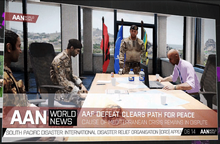
Peace talks being held in Kavala with Namdar present (far left)
Having been completely abandoned by CSAT, the AAF are forced to unconditionally capitulate to NATO forces and agree to an immediate ceasefire.
Though CSAT publicly continue to deny any involvement in the fighting, they are shown to be present at the peace treaty talks following the conflict's conclusion, and are due to sign a joint peacekeeping deal in-conjunction with NATO that would oversee the demilitarisation of the AAF.
Events of Apex Protocol (2035)
| SPOILER ALERT | ||||||
|---|---|---|---|---|---|---|
NOTE: This section contains spoilers from ArmA 3 Apex's 'Apex Protocol' campaign. In light of the Pacific disaster that inflicted massive destruction to much of the Horizon Islands, CSAT immediately offers to provide humanitarian aid and support to the beleaguered nation.
Though conventional Pacific CSAT forces are not actually present on the island of Tanoa during the events of Apex Protocol, CSAT's elite Viper special operations unit is deployed to the country in order to sow havoc amongst the country's population. They do so by supporting Syndikat, an anti-government insurgency group that was actively seeking to overthrow the civilian government, with weapons, equipment, and funding. At the same time however, conventional NATO forces in the region commence their "Safe Horizon" exercises aimed at helping the local government forces root out the insurgency. Despite their protests, the exercise goes on regardless of CSAT's disapproval. In reality, the exercise was a cover for CTRG operatives to insert into the country in order to retrieve one of their missing assets, as well as finding the source of Syndikat's funding and supplies. One successful mission after another gradually begins to chip away at Syndikat's strength, until the group's leader himself is eventually killed at the hands of CTRG. 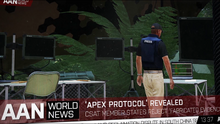 AAN journalists investigate one of Viper's black sites
To make matters worse, NATO forces (with the covert assistance of CTRG) eventually manage to secure one of Viper's black sites containing critical intel detailing CSAT's so-called 'Apex Protocol'. The papers revealed CSAT's elaborate scheme that was specifically designed to curtail Western influence in countries that had friendly relations to the United States and its allies. This revelation sends shockwaves throughout the international community, and marks the beginning of the end of the organisation. |
Post-Apex Protocol

In spite of the overwhelming evidence, CSAT continues to deny allegations of the Apex Protocol's existence
| « | Evidence of a deliberate, sustained, high-level effort to incite death and chaos, has brought into question the continued viability of the Canton Protocol Strategic Alliance itself. Leaders from across the world have united in a call for action, seeking to bring those responsible to justice swiftly. AAN report on the "Apex Protocol Papers"
|
» |
As a direct result of the extensive efforts of CTRG, CSAT's so-called 'Apex Protocol' was exposed to the world.
The release of the "Apex Protocol Papers" saw CSAT's methodology come under extensive scrutiny by the international community, as a decade of its unchecked soft power expansionism across the globe is called into question by the United Nations.
| « | By supplying dangerous criminals with military weapons, they have sought to murder the people of the Horizon Islands. They are illegitimate. Their time has come to an end! Benjamin Hope, President of the Horizon Islands, publicly denounces CSAT
|
» |
An emergency summit is immediately held with all member states in light of the revelations. However, CSAT begins to face the danger of fragmenting within itself, as its Eurasian, African, and Pacific members seek to distance themselves from the organisation.
With the fragile alliance now on the brink of collapse and its influence suddenly on the reverse, the world is slowly returning to the status quo. However, Eastwind's existence is never revealed by NATO and CTRG to the public. It remains unclear as to whether CSAT retains any further devices or the ability to manufacture additional units.
Events of Old Man (2038)
Despite the "Apex Protocol" revelations, the alliance has surprisingly rebounded from its losses and has slowly regained much of its lost influence over the past three years. Attempts from Western countries to subvert CSAT's growth have been largely halted, though the alliance continues to remain vigilant against subterfuge from its enemies.
In mid 2038, a super-strain of malaria strikes the Horizon Islands, with the country's Tanoa province being particularly hit hard by the outbreak. Despite the best efforts of Western governments and NGOs, no known methods of treating the disease have proven effective, and hundreds continue to perish from the disease with each passing day.
However, a change in leadership has occurred following the retirement of former president Benjamin Hope. The new leaders of the Horizon Islands government, chaired by a pro-CSAT political party named Nouveaux Horizons, agree to allow for an influx of humanitarian aid from CSAT.
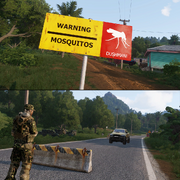
Jointly-operated Chinese/Tanoan checkpoints are built along the main roads leading into quarantine zones.
CSAT's medical teams are immediately dispatched to many of the quarantined settlements, and their treatments prove to be highly effective at stopping and curing the disease.
| « | Former president of the Horizon Islands, Benjamin Hope, has condemned government decisions regarding CSAT's militarization of Tanoa. Speaking at a fundraising event for Nouveaux Horizons, he condemned both foreign intervention and militant groups affiliated with L'Ensemble for exploiting the nation's current malaria crisis. La Roche agreed to Canton Protocol demands for combined counter insurgency operations with local gendarmes last week, sparking violent protests in Georgetown, Tanouka, and Ouméré. Radio report on the latest troop surge
|
» |
To "assist" with the continued aid relief, CSAT officials have demanded that their deployment mandate be extended to allow for the addition of more forces. With no viable alternative and no valid reasons to object, the government caves into CSAT demands and agrees to a troop surge.
| SPOILER ALERT |
|---|
NOTE: This section contains spoilers from ArmA 3's 'Old Man' campaign. From the onset of the crisis, the reality was that the entire outbreak was a man-made disaster that was deliberately caused by CSAT.  CSAT's troop surge is authorised by the Horizon Islands government following their successful handling of the crisis. After years of extensive research and development, the alliance's top scientists were able to artificially engineer a malaria strain that they dubbed as "Atrox". Atrox was unique for its ability to target specific human genotypes and be completely resistant to any known form of anti-malarial treatment. Like regular strains of malaria, Atrox was transmitted via mosquito bites but once a human who possessed targeted genotypes was infected, they would quickly succumb to the diseases' effects without special medication containing anti-Atrox counteragents. As a demonstration, the people of the Horizon Islands, specifically ethnic Tanoans, would serve as the ideal test subjects to prove the strain's virulence. Without the knowledge of the Horizon Islands government, hired smugglers and CSAT special operations had brought shipments of Atrox-contaminated mosquitoes into the country. They were released in numerous settlements and were the instigators behind the whole crisis. 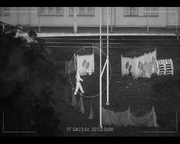 Aid teams planting crates with contaminated mosquitoes at random villages to propagate Atrox's spread. A research lab was also established on Tuvanaka to help scientists create samples of both the strain itself and its counteragent on-site. However, the deployment soon encounters a new problem in the form of an anti-government movement calling itself the L'Ensemble. The insurgents were slowly gathering momentum and sympathy from the public as the government's unquestioned support for the CSAT presence was deeply unpopular. Furthermore, an unknown insurgent was also causing much havoc with numerous quarantine zone checkpoints coming under attack. Eventually, even a SAM battery and the hidden lab are struck. Unfortunately, the lab was successfully raided and the insurgents were able to flee with a sample of the Atrox counteragent. Though the losses were regrettable, the Horizon Islands government nonetheless had no choice but to continue accepting CSAT requests in exchange for anti-Atrox vaccines. In turn, any remaining Western influence in the country was effectively stamped out by the crisis, making the Horizon Islands yet another successful addition into CSAT's fold. |
Events of First Contact (2039)
A year later, CSAT has continued to expand with the addition of new members - most prominently, the Republic of Belarus following the 2035 Moscow Summit. Attempts by its Western adversaries at sabotaging its growth have once again proven to be ineffective, demonstrating the alliance's resilience in the face of Western aggression.
However, Belarus' addition has also helped to ignite the spread of anti-CSAT paranoia throughout NATO's remaining Eastern European members. Though its acceptance has thus far been a liability, it has also allowed the alliance to exploit the incompetence of NATO leaders and place CSAT one step closer to reaching its main goal: Russia.
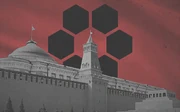
Following the offer, the Russian Federal Assembly deliberates on the question of full membership into the alliance.
| « | "A return to bilateral Cold War-era thinking could be disastrous for everyone. If the US continues to ignore the new world order, and insists on creating enemies where there are none, they run the risk of making their fears a reality." Russian officials denounce NATO wargames on the eve of a membership offer from CSAT
|
» |
NATO's commencement of joint military exercises near the Russian Federation's borders has been a boon to the organisation, fuelling Russian fears of NATO expansionism at its frontier, and pushing its leaders closer towards CSAT.
As of June 17th, 2039, the alliance has offered a lucrative deal to the Russian government in the hopes of solidifying its expansion into Eastern Europe. The Kremlin however, has yet to confirm any official decision regarding full membership.
Equipment
CSAT equipment is predominately made up of assets acquired from various countries; namely Russian arms manufacturers. Iranian and Chinese defence industries have also collaborated heavily in order to reverse engineer several weapons systems that are of both Eastern and Western design in origin.
Nonetheless, their forces utilise extremely advanced hardware that is on par with, if not superior to, their Western counterparts in almost every way.
For example, Iranian/Chinese CSAT soldiers are unique for their armoured fatigues which consist of two components; an over-suit camouflaged in their signature Hexacam pattern (for arid, urban, and tropical environments) and a bullet-resistant under-suit that is designed to provide ballistic protection from neck to toe against small arms calibres ranging up to 7.62 mm.

Hexacam camouflage patterns employed by CSAT forces in order from left-to-right:
- Brown (Iranian, Altis)
- Urban (Iranian, Altis)
- Semi-Arid (Iranian/Chinese; pilots only)
- Green/Tropic (Chinese, Tanoa)
- Arid/Desert (North African, Malden)
Because their fatigues are armoured by default, CSAT soldiers eschew the need for plate carriers like their NATO/AAF counterparts and can wear load bearing vests instead - allowing them to carry much more ammunition and equipment (certain specialist troops still opt to wear tactical vests).
On the other hand, their Defender/Protector/Assassin helmets provide the best ballistic protection and surface coverage out of all modern combat helmets.
However, it should be noted that not all CSAT forces are equally equipped to the same standards as their Iranian/Chinese counterparts. North African troops stationed on the island of Malden for instance, only wear unarmoured light fatigues and chest rigs - both of which lack ballistic protection. Likewise, many do not have access to combat helmets and only wear simple ball/military caps for headwear.
While on deployments, CSAT soldiers do not wear the flag patches of their home nation, and instead bear the six red hexagons of the CSAT emblem.
Arsenal
Gallery
Trivia
- CSAT as a whole is seemingly based on the real-world Chinese-led "Shanghai Cooperation Organisation", otherwise simply known as the "SCO".
- During the pre-Alpha phase of ArmA 3's development, CSAT was directly based on the real-world Iranian Armed Forces.
- In fact, config names for placeable groups in the editor continue to refer to CSAT (at least for Mediterranean forces) as the Iranian Armed Forces.
- It is specifically due to CSAT being based on the Iranian military that ArmA 3 was eventually banned for sale in 2012 by the Iranian government as a result.
- Prior to the unveiling of the Contact expansion, the Russian Federation and its armed forces were never outright stated to be a part of the organisation. It was mentioned however, that the coalition has held several summits at the capital Moscow, over the years.
- During the pre-Alpha, Russian forces in the form of the Raven Security private military company were meant to be present. They were assigned to guard CSAT facilities on Altis and would have been an OPFOR sub-faction.
- Though they no longer exist canonically, a leftover of these Russian forces remain in the form of the in-game equippable Raven Vest, along with several config references and unused textures related to the PMC group.
- On Bootcamp's release, Griffin Regiment was initially spelt as "Gryffin" instead but was later changed to Griffin for unknown reasons. The original name is still referred to as such in the game's files, as well as for the Regiment's shoulder insignia (string name: str_a3_cfgunitinsignia_gryffinregiment).
External links
See also
| Factions - REDFOR (ArmA 3) | |
|---|---|
| CSAT • Gendarmerie • Russian Spetsnaz • Viper | |
| Apex DLC | Contact DLC | |




